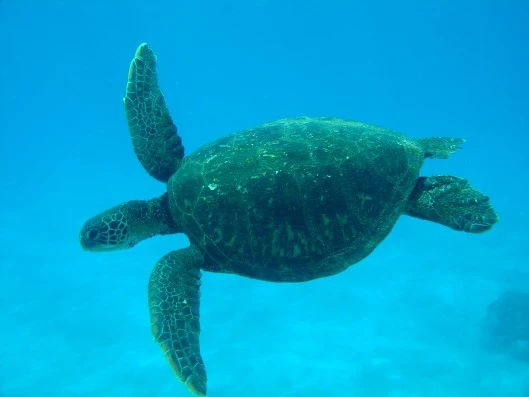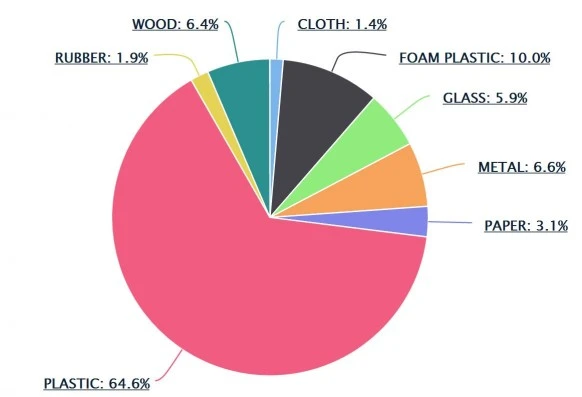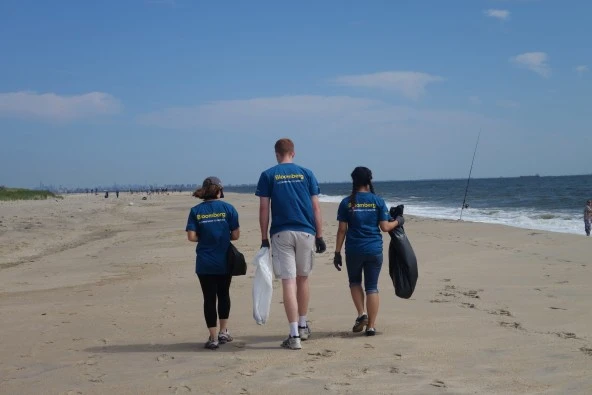Tackling Beach Pollution One Data Crunch At a Time
September 28, 2015

Cleaning up garbage from the beaches of southern Japan, the canals in London, or at the Jersey Shore engages our employees with local communities and improves the environment. That kind of commitment has inspired a select group of Bloomberg’s Global Data team to take a closer look at trash collected by volunteers from Bloomberg and other organizations. But they’re not just using rakes, buckets, and bags to clean sandy shores — these environmentally savvy employees are doing what they do best: crunch data.
“We collect tons of information on plastic, cloth, tires, and other items that get washed ashore, which we record in our own database,” says Mia Zhao who works in Global Data Sciences. Mia and Ikkei Itoku led the efforts to create the dashboards used to analyze the litter data. “The goal is to see if we can prevent pollution and also determine if the trash we picked up has any value as a commodity,” says Mia.
The project began this year when the Clean Ocean Action Organization (COA) reached out to Bloomberg with an appetite for better data interpretation to improve degraded water quality for New York and New Jersey coastlines. “COA came to us and thought we’d be the best people to help them. We’re evaluating beachfront pollution on a quantitative level. Our information gives COA and other organizations a new tactic in the battle to keep our beaches clean,” says Mia.
Through the power of analyzing data, here’s how a dedicated group of our employees are making our planet cleaner – and encouraging other organizations to do the same.

Data Means Everything
“We first started by manually normalizing a year’s worth of COA’s backlogged data,” says Anna Cianciara of Global Data’s Content Indexing team. Anna, along with Nicole Barberis and Eduardo Hermesmeyer of Global Data Sciences, methodically investigated and categorized COA’s information of garbage collected from the Jersey Shore, which included plastic bottles, rubber, glass, and other forms of waste.
The ability to purposefully measure and reallocate resources from the beach to a third-party waste management facility drove thoughtful discussion, but also created competition on the frontlines.
“Our beach cleanup volunteers are highly engaged and like to compete with each other, as they can see in real time how much waste they’ve collected,” says Global Data’s Mike Campellone, who serves as the project manager.
That’s thanks to the group’s two-tier approach. “The idea is to encourage other organizations to first record the trash collected using smartphone apps we designed and built, allowing them to see updates in real time. And secondly, by storing this information in a database that we can access and analyze back at the office,” says Mike.
Closing the Litter Loop
“I constantly questioned, ‘how much of X amount of waste could be valued at X amount of dollars?”’ says Anna.
“Recycled items like plastic, aluminum, or metals can still have a monetary value,” Mia echoes. “We’ve realized that cleaning up the beach is not only good for the environment, it also introduces a market for sustainable businesses.”
For example, after waste is collected it is transported to an environmental facility where it is valued and sold in the recycling market.
The group also introduced new ways to create awareness for companies whose material ends up on the beach. “If there’s a label associated with the garbage collected, like a Coca-Cola bottle, we can track how much trash we find associated from that brand. This might make corporations think harder about their carbon footprints,” says Anna.
The Global Data team is onto something big with plans to redefine the meaning of sustainability. Mike attests: “We are leveraging this work to be replicated globally to nonprofit organizations including American Littoral Society, Thames21, Arakawa CleanAid, and others. We will continue to use data to advocate for a cleaner planet.”

(Learn about Bloomberg Philanthropies’ Vibrant Oceans project.)
*The project’s team members would like to thank Nicole Barberis, Christian Bellmann, Chelsea Bentley, Elizabeth Campbell, Victoria Cerullo, Alex Gorden, Eduardo Hermesmeyer, Monica Hilliard, Wendy Huang, John Mahoney, Daniel Yielding, Bloomberg Philanthropy & Engagement, and – of course – Clean Ocean Action, for assistance and support of their efforts.*
(Contributed by TK Breuer, who works in Communications for Bloomberg, LP.)